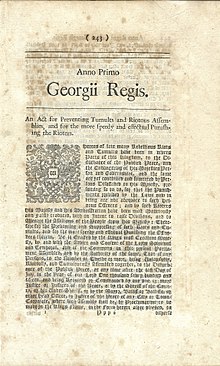| Act of Parliament | |
 | |
| Long title | An Act for Preventing Tumults and Riotous Assemblies, and for the more speedy and effectual Punishing the Rioters |
|---|---|
| Citation | 1 Geo. 1. St. 2. c. 5 |
| Dates | |
| Royal assent | 20 July 1715 |
| Commencement | 1 August 1715 |
| Repealed | 21 July 1967 |
| Other legislation | |
| Amended by | |
| Repealed by | Criminal Law Act 1967 |
Status: Repealed | |
| Text of statute as originally enacted | |

The Riot Act[1] (1 Geo. 1. St. 2. c. 5), sometimes called the Riot Act 1714[2] or the Riot Act 1715,[3] was an act of the Parliament of Great Britain which authorised local authorities to declare any group of 12 or more people to be unlawfully assembled and order them to disperse or face punitive action. The act's full title was "An Act for preventing tumults and riotous assemblies, and for the more speedy and effectual punishing the rioters", and it came into force on 1 August 1715.[4] It was repealed in England and Wales by section 10(2) and Part III of Schedule 3 of the Criminal Law Act 1967. Acts similar to the Riot Act passed into the laws of British colonies in Australia and North America, some of which remain in force today.
The phrase "read the riot act" has passed into common usage for a stern reprimand or warning of consequences.
- ^ a b This short title was conferred by the Short Titles Act 1896, section 1 and the first schedule.
- ^ Turner, J. W. Cecil (1964) [1962]. Kenny's Outlines of Criminal Law (18th ed.). Cambridge: Cambridge University Press. p. lvii.
- ^ St Clair Feilden, H.; Gray Etheridge, W. (1895). A Short Constitutional History of England (3rd ed.). B H Blackwell. Oxford. Simpkin, Marshall, Hamilton, Kent & Co. p. 335.
- ^ Stevenson, John (2014). Popular Disturbances in England 1700–1832. Routledge. p. 29. ISBN 9781317897149. Retrieved 30 July 2018.